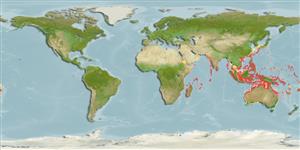Environment: milieu / climate zone / depth range / distribution range
Ecology
Marine; reef-associated; depth range 2 - 50 m (Ref. 37816). Tropical
Indo-West Pacific: Reunion and Maldives, eastward through Indonesia and Papua New Guinea to the Coral Sea, and northward to Japan.
Size / Weight / Age
Maturity: Lm ? range ? - ? cm
Max length : 80.0 cm TL male/unsexed; (Ref. 9184)
Found primarily in coral reefs. Also occurs in temperate waters. Solitary (Ref. 90102).
Life cycle and mating behavior
Maturity | Reproduction | Spawning | Eggs | Fecundity | Larvae
Matsuura, K., 1994. Arothron caeruleopunctatus, a new puffer from the Indo-western Pacific. Jap. J. Ichthyol. 41(1):29-33. (Ref. 9184)
IUCN Red List Status (Ref. 130435: Version 2024-1)
Threat to humans
Harmless
Human uses
Fisheries: of no interest; aquarium: commercial
Tools
Special reports
Download XML
Internet sources
Estimates based on models
Preferred temperature (Ref.
123201): 24.6 - 29, mean 27.8 °C (based on 710 cells).
Phylogenetic diversity index (Ref.
82804): PD
50 = 0.5000 [Uniqueness, from 0.5 = low to 2.0 = high].
Bayesian length-weight: a=0.03715 (0.01590 - 0.08679), b=2.87 (2.70 - 3.04), in cm total length, based on LWR estimates for this Genus-body shape (Ref.
93245).
Trophic level (Ref.
69278): 3.5 ±0.5 se; based on size and trophs of closest relatives
Resilience (Ref.
120179): Medium, minimum population doubling time 1.4 - 4.4 years (Preliminary K or Fecundity.).
Fishing Vulnerability (Ref.
59153): Moderate to high vulnerability (52 of 100).
Nutrients (Ref.
124155): Calcium = 24.7 [10.0, 60.2] mg/100g; Iron = 0.49 [0.25, 1.07] mg/100g; Protein = 18.5 [16.3, 20.7] %; Omega3 = 0.0983 [, ] g/100g; Selenium = 43.4 [21.7, 92.0] μg/100g; VitaminA = 34.9 [9.9, 122.6] μg/100g; Zinc = 0.804 [0.547, 1.201] mg/100g (wet weight);
